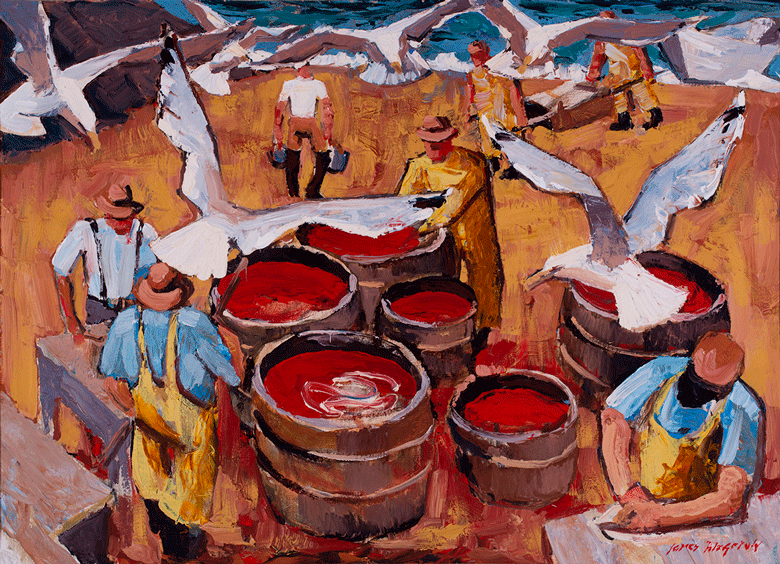During his life as a painter, James Fitzgerald (1899-1971) knew firsthand a number of working waterfronts. After completing his art studies in his home city of Boston, he took to the sea, shipping out of Gloucester, ostensibly to sketch and paint.
On later trips to the Grand Banks aboard the schooner Elizabeth Howard, he paid his first visit to Monhegan Island in 1924. Around 1930 he relocated to Monterey, Calif., where he resumed his painting, finding some of his subjects on the docks: net menders, sardine fishermen, fishing vessels tied up.
Fitzgerald’s move to Monhegan in 1943 confirmed his passion for waterfront subjects. Working in oil and watercolor, he portrayed the fishermen, often in their yellow rain gear, hauling nets, pulling traps, rowing. As Robert Stahl writes in James Fitzgerald: The Watercolors, Volume II of his brilliant catalogue raisonné of the artist’s oeuvre, the island provided him with “an immersive experience in the forces of nature and the activities of the men who made their livelihood on its surrounding waters.”
Stahl surmises that one of the “old weather-beaten structures” may have provided Fitzgerald with a venue “to observe undisturbed…”
The working waterfront on Monhegan Island consists, more or less, of a wharf and Fish Beach, which together have inspired thousands of paintings over the past century and a half or so. While the dynamics of that waterfront have changed over the years—Trap Day, for example, shifted from Dec. 1 to Oct. 1 in 2006—in James Fitzgerald’s time the shoreline facing Manana Island was a bustling place.
Stahl surmises that one of the “old weather-beaten structures” along the beach may have provided Fitzgerald with a venue “to observe undisturbed while also furnishing a vantage to catch the activities from above.” Interesting to note that he was not a plein air painter despite the immediacy of his work. He was known to observe his subjects outdoors, then return to the studio to “recreate images from a mental template.”
Among Fitzgerald’s waterfront images is a stunning overhead view of fishermen engaged in salting mackerel, one of the stars of “The Odyssey of James Fitzgerald” at the Monhegan Museum of Art and History. It’s a seven-person operation, each man playing a role: hauling, cutting, dressing, salting.
Stahl explains the blood-red barrels.
“In those days,” he writes, “so many fish were caught in the Monhegan waters that when they were cleaned and rinsed before being salted, the large barrel tubs (called ‘butts’) would turn red with blood.” The enterprise drew seagulls; Fitzgerald painted them hovering over the fishermen’s heads, their beaks pointed downwards, ready to snag some mackerel.
Painted in brusque strokes, “Saltin’ Mackerel” is a flurry of activity, top to bottom, edge to edge. The way Fitzgerald manages to catch the action is astonishing.
“The Odyssey of James Fitzgerald” is on view July 1-Sept. 30. Visit www.monheganmuseum.org for information.





